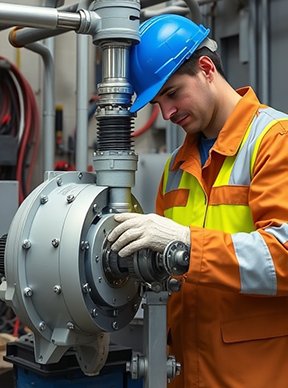Published: April 15, 2014 | Updated: September 15, 2025
Published: April 15, 2014 | Updated: September 15, 2025
13 Proven Strategies for Industrial Preventative Maintenance Excellence
Industries of all nature have the relentless pursuit of peak efficiency and reliability. A single, unexpected equipment failure can trigger a cascade of disruptions, leading to costly downtime, missed production targets, and even safety hazards. To mitigate these risks, companies need to implement a solid and effective preventative maintenance (PM) program. This article delves into thirteen actionable strategies designed to elevate your industrial PM efforts, transforming them from reactive responses to proactive measures that safeguard your assets and ensure operational continuity.
Whether you manage a sprawling utility network, a high-throughput ethanol plant, or a dynamic construction site, the principles of effective preventative maintenance remain universally applicable. By embracing these insights, you can move beyond simply fixing breakdowns to anticipating and preventing them, fostering a culture of reliability that drives long-term success. Throughout this discussion, think how a computerized maintenance management system (CMMS) can assist in organizing your PMs.
 Show Us Your Best Assets: The Foundation of Proactive Care
Show Us Your Best Assets: The Foundation of Proactive Care
The cornerstone of an effective preventative maintenance (PM) strategy lies in a comprehensive understanding of your assets. Beyond mere inventory, this involves rigorous data collection: location, operational history, condition, and projected lifespan. Detailed records build the foundation for targeted maintenance interventions. This meticulous approach allows for informed decisions, ensuring that resources are allocated strategically to maximize asset longevity and operational efficiency.
Build your list in a CMMS with all of the above criteria and more. Attach the relevant inventory to the assets. Read further about planning your PMs. Assign those to your assets.
Audit Your Assets: Strategic Decision-Making and Resource Allocation
Once your assets are meticulously documented, a critical audit becomes paramount. This audit demands a strategic examination of each asset's viability and the cost-effectiveness of its maintenance. Ask crucial questions: Does the cost of continuous repairs exceed the benefits of replacement? Would a potential shutdown due to equipment failure justify proactive replacement? Evaluate inventory levels to ensure you have necessary spares without incurring excessive storage costs. This strategic approach ensures resources are allocated effectively, maximizing return on investment.
You can use a CMMS work order/maintenance history, equipment readings, and depreciation features to determine the cost-effectiveness of ongoing PMs.
Size Up the Troops: Empowering Your Maintenance Team Through Skill Assessment
What constitutes your most valuable asset? Your maintenance team. Assess their skills, qualifications, and experience to ensure they are equipped to handle the demands of your PM program. Identify skill gaps and provide targeted training to address them. Ensure adequate staffing levels to cover routine maintenance, preventative tasks, and potential absences. A well-trained and adequately staffed team is crucial for the successful execution of your PM strategy.
Using the CMMS, you can assign workers, crews, crafts, or shifts to conduct the PMs.
Discover how streamlined maintenance processes can elevate production. Learn more.
What's the Plan, Stan? Crafting a Strategic PM Blueprint
With a clear understanding of your assets and team, you can develop a comprehensive PM plan. This plan should outline specific maintenance tasks, schedules, and responsibilities. Define the frequency of routine and preventative maintenance for each asset. Establish clear procedures for work order management and accountability. This strategic blueprint will guide your team and ensure that all maintenance activities are performed in a timely and efficient manner.
With a quality CMMS, you can create your list of PMs, add relevant inventory, and assign them to the assets.
Make the Plan Clear: Communication and Collaboration
Effective communication is essential for the successful implementation of your PM plan. Ensure that all team members understand their roles, responsibilities, and the overall objectives of the program. Encourage feedback and suggestions from your team, as their insights can lead to valuable improvements. Open communication fosters a collaborative environment where everyone is invested in the success of the PM program.
Many CMMS features allow you to do this. Comments and eve after the fact work orders.
Hold Staff Accountable: Ensuring Task Completion and Performance
Accountability is crucial for maintaining the integrity of your PM schedule. Assign specific tasks and equipment to individual team members to eliminate ambiguity and ensure that all work orders are completed on time. Implement a system for tracking and reporting on maintenance activities to monitor progress and identify any potential issues. This level of accountability ensures that your PM plan is executed effectively and consistently.
The CMMS offers numerous reports for labor stats. On-time completion reports and attainment reports are two examples.
 Perform Routine Walkthroughs and Inspections: Proactive Problem Detection
Perform Routine Walkthroughs and Inspections: Proactive Problem Detection
Regular inspections identify potential problems before they escalate into major failures. Train your team to conduct thorough visual, auditory, and tactile inspections of equipment. Encourage them to document any anomalies or potential issues they observe. This proactive approach to problem detection allows you to address minor issues before they lead to costly downtime.
Example for a Utilities Company: During a routine walkthrough, a technician notices a slight vibration in a large transformer. This early detection allows for a closer inspection and potential tightening of loose bolts, preventing a future outage.
Keep Checklists: Standardizing Maintenance Procedures for Consistency
Checklists are invaluable tools for standardizing maintenance procedures and ensuring consistency. Develop detailed checklists for common maintenance tasks, covering all critical steps and procedures. These checklists serve as a guide for your maintenance team, helping them to perform tasks efficiently and accurately.
With a CMMS, you can add simple or advanced checklists to your PMs. Simple means the worker simply checks a box when complete. With the advanced, the technician inputs certain information such as equipment readings before moving to the next step.
Example for an Ethanol Plant: A checklist for inspecting a distillation column might include verifying pressure and temperature readings, checking for leaks in piping and valves, and inspecting insulation for damage.
Documentation: Maintaining a Comprehensive Record for Traceability
Comprehensive documentation is essential for tracking maintenance activities, identifying trends, and ensuring compliance with regulatory requirements. Maintain detailed records of equipment manuals, maintenance histories, work orders, and inspection reports. An organized and easily accessible documentation system will streamline maintenance operations and provide valuable insights into equipment performance.
Again, the CMMS offers numerous reports such as key performance indicators reports to help you keep assets functioning as a baseline level.
Example for a Construction Company: Detailed records of maintenance performed on heavy equipment, such as excavators and bulldozers, track wear and tear, identify potential issues, and ensure compliance with safety regulations.
Training: Continuous Improvement and Adaptation to New Technologies
Continuous training and development are essential for keeping your maintenance team up-to-date with the latest technologies and best practices. Invest in training programs that cover topics such as equipment maintenance, troubleshooting, and safety procedures. This ongoing commitment to training will enhance your team's skills and knowledge, enabling them to perform their duties more effectively.
Audit Your Process: Identifying Areas for Enhancement and Refinement
Regularly review and evaluate your PM process to identify areas for improvement. Analyze maintenance data, work order reports, and inspection findings to identify trends and patterns. Don't hesitate to address any weaknesses or inefficiencies in your process. This continuous improvement approach will ensure that your PM program remains effective and efficient.
Purchase a Maintenance Management System: Leveraging Technology for Enhanced Efficiency
In above sections, you've seen how a computerized maintenance management system (CMMS) gives you an indispensable tool for managing your PM program. For PM scheduling, make sure you invest in a system that offers a calendar for drop-and-drag options for PM work orders. .
Implement Your CMMS: Putting Technology to Work for Tangible Results
Simply purchasing a CMMS is not enough; you must implement it effectively. Ensure that all team members receive training on how to use the system and that it integrates with your existing workflows. A well-implemented CMMS will provide valuable insights into your maintenance operations and help you make data-driven decisions.
CMMS and Preventive Maintenance: Sustaining Industries Together
The strength of an industrial preventative maintenance system does not reside in the accumulation of isolated actions but in the cultivation of a dynamic, adaptive strategy. It is the unwavering commitment to continuous improvement, the keen awareness of your team's potential, and the strategic integration of technology that will truly elevate your maintenance program. The pursuit of excellence is not a destination, but a perpetual journey, one where proactive anticipation and a culture of reliability serve as the compass guiding your operations towards sustained success.
FAQs
What is a CMMS and how does it improve preventative maintenance?
A CMMS organizes work orders, schedules, and asset histories, helping companies prevent breakdowns and reduce downtime.
How does MAPCON’s CMMS support asset management?
MAPCON allows you to build detailed asset records, track maintenance history, and attach inventory, making asset care more efficient.
Why is preventive maintenance important in industrial operations?
Preventive maintenance reduces costly downtime, extends equipment life, and helps maintain safe working conditions.
Can a CMMS help with team accountability?
Yes, CMMS systems like MAPCON provide reports on task completion and labor performance, ensuring maintenance goals are met.
What features should I look for in a CMMS?
Look for scheduling tools, asset tracking, inventory management, reporting, and mobile access for maximum efficiency.
How can training improve a preventative maintenance program?
Training ensures maintenance staff stay skilled and updated, allowing them to carry out PM tasks more effectively.
MAPCON | 800-922-4336
MAPCON CMMS software empowers you to plan and execute PM tasks flawlessly, thanks to its wealth of features and customizable options. Want to see it for yourself? Click the button below to get your FREE 30-day trial of MAPCON!
Try It FREE!